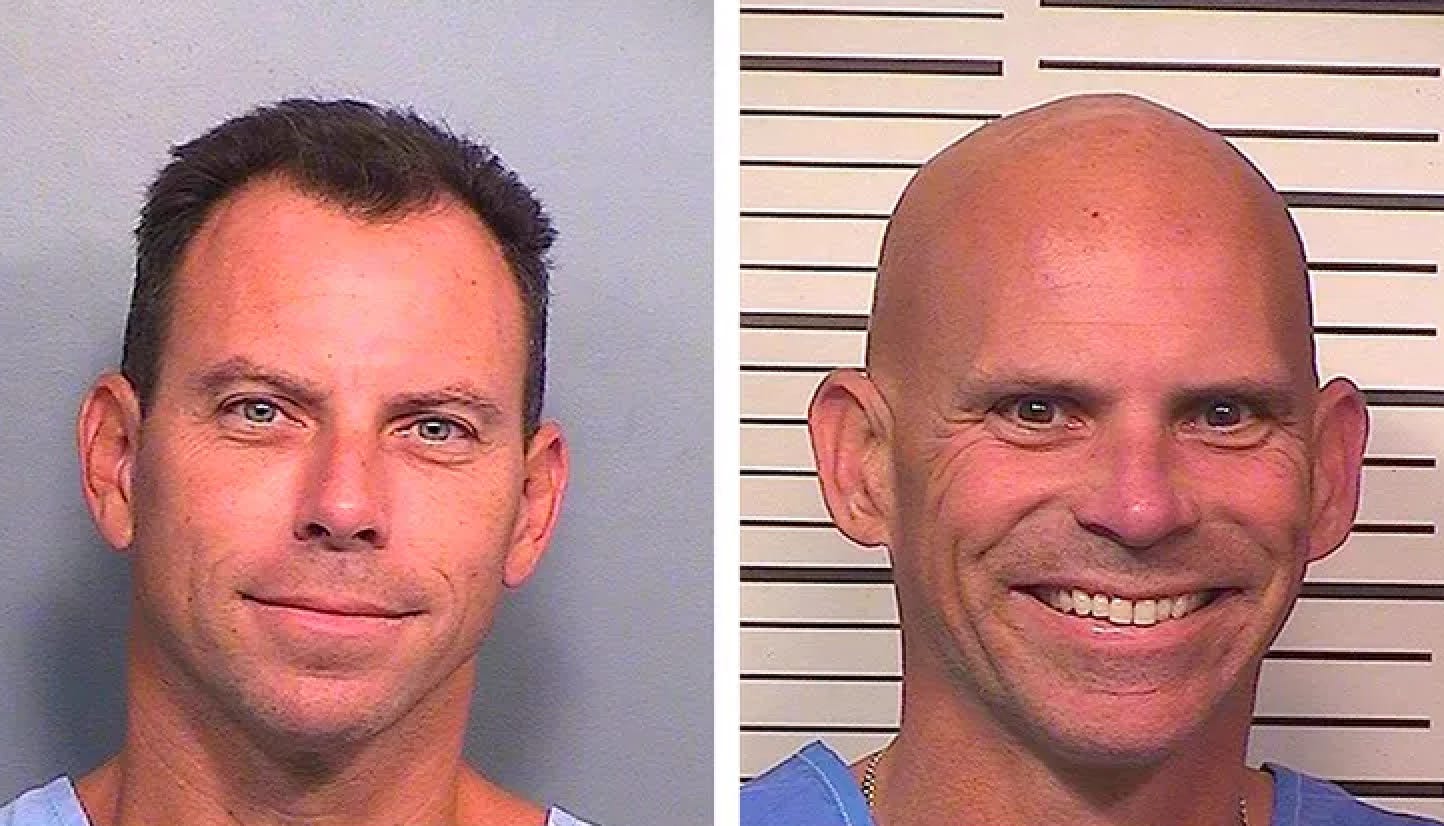Blood Brothers
My own sense of the Menendez case is that the “real awful” father spawned two real awful sons.
Having gone through the reputation rehabs of all the female celebrities who scandalized us in the 90s (Britney Spears, Pamela Anderson, Paris Hilton), we are now relitigating 90s celebrity murders. I gorged on all nine episodes of the latest Netflix noir fest from Ryan Murphy, Monsters: The Lyle and Erik Menendez Story, about the two preppy Menendez brothers who blew the heads off their parents at close range with 12-gauge shotguns as they watched TV in their $5 million Beverly Hills mansion.
After the OJ Simpson story broke, most of us forgot about the Menendez brothers (In a superbly echt 90s collision, OJ was in the cell next to Erik in the LA County Men’s Central Jail.) But the brothers have been serving their sentences of life without parole since 1996. In the brothers’ second trial, after the first ended in hung juries, the judge excluded their claim that their father had raped and sexually tormented them for years, and that their terror that he would kill them led to their violent act of parricide. If that is true, it doesn’t explain why their unfortunate mother–futile, enabling Kitty Menendez–should also have wound up riddled with bullets, nor does it explain the boys’ reckless $700,000 shopping spree after the crime, blowing $15,000 on three Rolex watches and $64,000 on a Porsche Carrera with their father’s newly liberated money. The series has stoked the Gen Z campaigns on TikTok to win their release, and LA County District Attorney George Gascón is reviewing the case and will soon recommend whether their severe sentences should stand.
Perhaps nothing emphasizes the passage of 34 years more than the photo of Lyle Menendez as he looks today. The once thatch-haired heartthrob, now 56, is bald as an egg with a faint resemblance to Michael Milken, the former junk bond king and another celebrity ex-felon of the 90s. (Milken was pardoned by Trump in 2020. Let’s, please, not have a show about him too.)
What the passage of years seems to have confirmed is that the successful entertainment executive José Menendez was indeed a sexual predator and a sadist. A member of the 90s boy band Menudo has come forward to say that José sexually molested him when he was 14, and Menendez cousin Andy Cano has produced a contemporaneous letter from Erik, written a few months before the murders, describing his fear of his father coming into his bedroom. In the not uninteresting documentary that followed the Netflix series (yes, I watched that too), even the caustic then-deputy District Attorney Pamela Bozanich tells us she couldn’t find a single person to testify to José’s good character. “The loss of José Menendez, in my mind, was an actual plus for mankind. José Menendez was a real awful man,” she admits.
In prison, Erik has spent his time working with the terminally ill. Lyle has offered pastoral help to prisoners who also suffered from sexual abuse. Bozanich is nonetheless irritated by the vociferous “let them out” campaign. “The only reason we’re doing this special (documentary) is because of the TikTok movement to free the Menendi,” she says. “If that’s how we’re going to try cases now, why don’t we just, like, have a poll?... Your beliefs are not facts,” she says, addressing Erik and Lyle’s Gen Z fan club.
No, but I was fascinated by the report over the weekend about a different case and the actions of 90-year-old Judge Frederic Block, who, in a Brooklyn courtroom in 1997, handed down five consecutive life sentences to repeat offender Walter Johnson, convicted of, among other things, robbery, cocaine possession, and witness tampering. Judge Block freed Johnson last week after 27 years. “Judges gain insights that with the passage of time only can come with experience on the bench and their judicial maturation,” Judge Block wrote in his decision granting Johnson’s petition for release. He added: “Just like prisoners who have evolved into better human beings during their lengthy periods of incarceration, judges also evolve with the passage of years on the bench.”
My own sense of the Menendez case is that the “real awful” father spawned two real awful sons. But after 34 years behind bars, it's time to accept that the tortured Lyle and Erik may also have evolved.
Diva Fever
Now that my beloved, neurodivergent, 38-year-old son Georgie lives with me, there’s no escaping the highly charged build-up to Halloween. He starts seeking (mostly ignored) familial guidance on his costume circa the end of August. He has never understood that it's important that people actually recognize who you are supposed to be. For five years, he was obsessed with being Goldie Hawn, who plays the entitled diva Joanna Stayton in the cheesy 1987 comedy Overboard. But, 37 years after it came out, she's not exactly the first movie character on the minds of trick-or-treaters suiting up as Beetlejuice’s Shrunken Head Bob.
For another four years, he wanted to be the totally obscure Meredith Blake, the self-absorbed stepmother who is absurdly hoity-toity on a family camping trip in the 1998 remake of The Parent Trap. Harry and I would have to brief baffled friends to shout “OMG Meredith Blake!” when Georgie sashayed in wearing an Ascot hat and waving a glass of champagne.

This year, his sister Izzy has persuaded him to effort a tiny bit of cultural relevance by being, ok, another over-the-top diva (we can unpack the maternal psychology of this motif later): Jean Smart’s throaty Vegas comedienne in the HBO comedy Hacks. Amazon boxes have started to arrive containing glittery pantsuit ensembles and dangly earrings. Last night, however, I heard through the bedroom door he had regressed to watching Overboard again, so I have a sinking feeling the new approach is not sticking.
The Resister
Today sees the publication of Patriot, the diary written by the late Russian political prisoner Alexei Navalny during his three barbarous years in Putin’s various penitentiary hellholes, the last one known as Polar Wolf and located north of the Arctic Circle.
I will always remember where I was on February 16, 2024 when I heard the news alert announcing that Navalny had died. I was driving to Quogue at 6am and was so gutted I stopped the car and wept. The book, a friend of Navalny told me, has been somewhat cleansed of the most gruesome details of what he endured in captivity, out of consideration for his 70-year-old mother. Leaked Russian documents, however, show that the "official investigator" sent by Moscow covered up and removed sections from the initial report that showed Navalny clearly died from poisoning shortly after he was served lunch in his solitary confinement cell.
Navalny‘s mordant stoicism is all over Patriot. He noted that he and Putin have a very similar lifestyle: they both have high walls around where they live. They both have loudspeakers blasting “Glory to the FSB.” Putin keeps his ministers waiting for six hours, just as Navalny’s lawyers have to wait six hours to see him.
The flipness only reinforces his heartbreaking clarity in the face of almost certain death. “If your convictions mean something, you must be prepared to stand up for them and make sacrifices if necessary,” Navalny writes. “And, if you’re not prepared to do that, you have no convictions. You just think you do.”
I am reminded of the words of another Russian dissident, Masha Gessen, who now lives in exile: “In war, you are either a collaborator or a resister.” Most of us would like to answer with the proud declaration, I’m a resister. But the truth is that most of us aren’t. Corporate timidity has muzzled journalism. In politics, the noble pronouncement “That's a resignation issue for me!” feels hopelessly old school as once grand figures of the US Congress hang around eating Trump’s humiliations just to keep their perk-laden jobs. New York Times columnist Bret Stephens once told me that, during a drive across Normandy, he kept seeing statues in village squares of heroes of the French resistance. Then he realized it was always the same guy, Jean Moulin, the moral giant who organized the scattered forces of the resistance against German occupation and later died after being tortured by the Gestapo. In the US, we have cheapened the word hero, but real heroes have always been desperately rare.
In his captivity, Navalny tells us he developed what he called his “prison Zen,” which included imagining the worst thing that could happen and accepting it. The worst thing did happen. We are left to dream of the day when there is a statue of Navalny in every Russian village square.







Appreciated especially the last section about heroes. So many rationalizations available to avoid the heroism of a Navalny. I'm quite sure I'd seize on one to avoid the sacrifice.
Tina,
I am hooked on your Substack. It's as if I am having lunch with you weekly and hearing all the various thoughts on your mind now. Thank you for sharing Georgie's Halloween journey. Whatever he creates with all of those Amazon styles will no doubt be a showstopper! xo